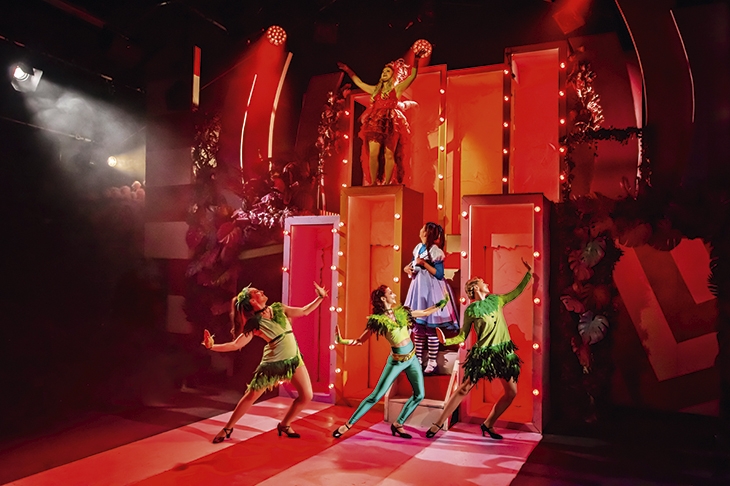Sam Shepard was perhaps the gloomiest playwright ever to spill his guts into a typewriter. The popularity of his work must owe itself to some deep grudge nursed by America’s elite against the redneck states. True West is a standard Shepard ordeal: a pair of damaged, inadequate, bitter, loveless white males are cudgelling each other to pieces in a dingy Californian hellhole. For good measure he adds a dollop of bad plotting and improbable detail.
We meet two thick angry brothers, Austin and Lee, living together in the house of their absent mom. Austin is busy writing a screenplay and Lee wants to borrow Austin’s car to go on a burglary spree. Austin hands over the keys because he needs a bit of privacy for a meeting with a film producer in the kitchen. Come off it. No producer would hold a script meeting at an unknown scribbler’s mother’s house. The producer arrives but the conversation is interrupted by Lee, now bearing a TV looted from a neighbouring home, who starts to schmooze the producer with an idea for a cowboy movie. The producer likes Lee’s idea so much that he tells Austin to scrap his current project and to start writing Lee’s screenplay instead. Is that possible? Just about.
But Austin, instead of accepting this commission, turns it down even though completing the screenplay for Lee would give him control of the entire project. More nonsense emerges as the story edges forward. The producer talks about huge sums of money being offered for Lee’s movie, which exists only as a synopsis and which has no named actor or director attached to it. That’s bunkum. The best these rookies could hope for is an 18-month option worth a hundred bucks. Shepard adds a bit of suspense by hinting that the producer has been attacked on a golf course, possibly by Lee, but this turns out to be a hoax. That kind of clumsy and wasteful plotting suggests that the characters aren’t developing in ways that serve the story or stimulate the audience. And that’s no surprise. Shepard is good at creating foul-mouthed dimwits but he’s hopeless at making them do anything other than behave like foul-mouthed dimwits.
Running short of ideas, he turns to surrealism. Lee murders a typewriter with a golf club while Austin makes 22 pieces of toast using eight toasters connected to a single electric socket. Literary professors will enjoy analysing this impenetrable scene. I should add that Austin is played by the heart-throb Kit Harington, who looks resoundingly unattractive in a pair of beige slacks, a boring T-shirt, a mouldy hairdo and a Saddam Hussein moustache. In the second half his character changes, for unclear reasons, and he becomes a giggling nincompoop lounging in his shorts on the nylon carpet sucking at a flask of bourbon. I mention the shorts because Harington has many female fans who attend his plays hoping for a glimpse of Kit minus his kit. These ogling connoisseurs will have to make do with a full-frontal view of Harington’s pale legs, lightly downed with spidery follicles, from shin to mid-thigh. That’s all there is.
In the closing scenes the action shifts to the Mojave desert which is indicated by sun-scorched dunes that replace the kitchen wall. Then we return to the kitchen with the scorched dunes still in view, but no wall. Has the Mojave engulfed the house? Impossible to say. I couldn’t wait to escape this opaque, witless and dementedly pessimistic horror show.
When I was a kid no one in Britain had heard of Dr Seuss. I fully expected to be mystified by Seussical. And so I was. The plot centres on Jojo, an imaginative but lonely girl, whose conformist parents instruct her never to think for herself. Jojo befriends the Cat in the Hat and they go on some kind of adventure involving a large bespectacled actor who turns out to be an elephant. My son explained the story afterwards but I wasn’t interested. I already knew what I’d witnessed, albeit with uncomprehending eyes.
This show is a sensation. It features 75 minutes of the tightest choreography I’ve seen outside the West End. The costumes are a cloudburst of lurid pastels whose exaggerated stylings are nevertheless elegant and chic. The dancing girls wear clingy outfits, which might be sexy but seem entirely chaste. Marc Pickering, as the Cat in the Hat, has a quiet charm and a balletic physical technique that raises his comedy to an astonishing pitch of excellence.
At the end, there were kids bopping in the aisles and parents clapping and roaring. The audience included young adults revisiting characters remembered from their childhoods. It’s rare for a kids’ show to attract punters without kids. Take note, impresarios. This amazing production deserves to set off on its travels soon.







Comments